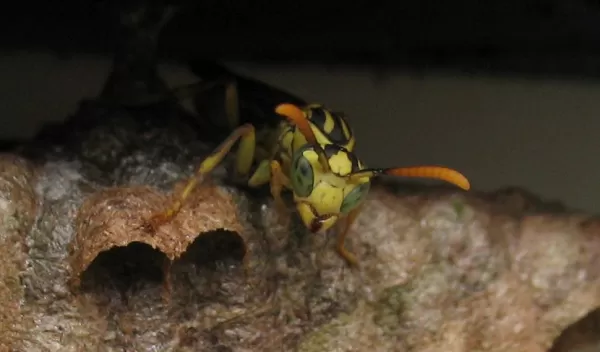
Tiny brains, but shared smarts
A solitary wasp--the kind that lives and forages for food alone--has a fairly small brain. Type out a lowercase letter in 10-point text and you'll get an idea of its size.
But tiny as that brain is, its social cousins, living together in honeycombed nests, have even smaller ones. And that size difference might provide some key information about the difference between insect societies and vertebrate societies.
Biologists have studied the societies of vertebrates--from flocks of birds, to schools of fish, to communities of humans--enough to come up with something called the "social brain hypothesis." Generally, it goes something like this: Social interaction presents challenges that require a lot of brain power, as that interaction requires organisms to navigate complicated territory, including avoiding conflict and building alliances.
Therefore, vertebrates that live in societies have bigger brains. The more complex the organism's society, the bigger its brain regions for processing complex information will be. Scientists believe the complexity of human societies may be one of the reasons we have such large, developed brains.
Sean O'Donnell, a biology professor at Drexel, has spent almost the entirety of his more than 20-year career studying wasps. He says these picnic terrors--actually critical members of the insect world that prey on pest species--represent ideal candidates for seeing whether that hypothesis applies to insects, because they have so much variation.
Some wasps are solitary. Some live in small, primitive groups. Others live in larger, more complex societies. "There are lots of intermediate stages," O'Donnell said.
When O'Donnell, with support from the National Science Foundation's Directorate for Biological Sciences, looked at the brains in 29 related species of wasps spanning the social spectrum, he found that living in a society did indeed affect the size of their brains. It just made them smaller, instead of bigger.
His findings are described in the latest issue of Proceedings of the Royal Society B.
"If our data is verified, it suggests that there's something really different about how insect societies formed," he said.
O'Donnell's work focused on the "mushroom bodies" of the wasps' brains, structures that are superficially similar to the regions of vertebrate brains that deal with higher cognitive functions.
His research uncovered another interesting difference from vertebrates: the complexity of the wasps' societies seemed to have no significant effect on the size of their brains. The big dropoff in size occurred between solitary and social wasps. In contrast, the brains of wasps in simple societies showed no significant size differences between those in complex societies.
"That suggests to me that going from solitary to a small society is the significant transition," O'Donnell said.
'Sharing' brainpower
Part of what makes vertebrate societies so brain-intensive is that they usually involve groups of organisms with different agendas that aren't related to one another--most of the people you know aren't members of your family.
Insect societies, however, are made up of groups of cooperating close relatives with shared objectives. Wasps might not need the type of brainpower required for social interaction because there's much less of it in their nests and colonies. The insects cooperate and rely on each other without the type of negotiation that can be required in vertebrate societies.
But what advantage could a smaller, less complex brain offer a species? As O'Donnell puts it, "Brains are expensive."
Neural tissues require more energy to develop and maintain than almost any other kind, and biologists have found that natural selection will find the optimal balance between the metabolic costs of developing particular areas of the brain and the benefits yielded.
In some ways, the social wasps may "share" brainpower. Individually, their brains might not stack up to their solitary relatives, but the colony as a whole is "smart."
O'Donnell says the next steps for his work will replicate the wasp research with termites and bees, which also offer a variety of social complexity.
"We would expect to see similar patterns," he said.
Learn more in this Drexel University video on Sean O'Donnell's work.
